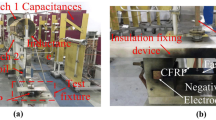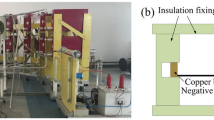Abstract
Lightning strikes pose a serious natural threat to carbon fiber-reinforced polymers (CFRPs). Knowledge of the electrical current distribution is essential for modeling the interaction between CFRP with lightning. In most applications, the anisotropy of CFRP makes the electrical current tend to concentrate on the surface, having significant influence on the current distribution. The conductivity through the thickness direction was studied with pulse generators and a dedicated four-probe fixture. Nonlinear effects were observed not only for 6.4/69 \(\upmu \hbox {s}\) lightning pulses, but also for 20/500 ns pulses with much less energy, in all the three tested composites. The electrical breakdown is a fast process, with voltage spikes observed in the leading edge for a few nanoseconds. After the spikes, the transient resistance remains approximately constant. Similarities could be found with the phenomena involved in thin polymer film breakdowns.



















Similar content being viewed by others
References
Abdelal G, Murphy A (2014) Nonlinear numerical modelling of lightning strike effect on composite panels with temperature dependent material properties. Compos Struct 109:268–278
Ogasawara T, Hirano Y, Yoshimura A (2010) Coupled thermal-electrical analysis for carbon fiber/epoxy composites exposed to simulated lightning current. Compos Part A Appl Sci Manuf 41(8):973–981
Smorgonskiy A, Rachidi F, Rubinstein M (2014) Modeling lightning current distribution in conductive elements of a wind turbine blade. In: International Conference on Lightning Protection (ICLP), Shanghai, China, pp 1415–1417
Weber M, Kamal MR (2010) Estimation of the volume resistivity of electrically conductive composites. Polym Compos 18(6):711–725
Xiao J, Li Y, Fan WX (1999) A laminate theory of piezoresistance for composite laminates. Composscitech 59(9):1369–1373
Greenwood JH, Lebeda S, Bernasconi J (1975) The anisotropic electrical resistivity of a carbon fibre reinforced plastic disc and its use as a transducer. J Phys E Sci Instrum 8(5):369–370
Tse KW, Moyer CA, Arajs S (1981) Electrical conductivity of graphite fiber-epoxy resin composites. Mater Sci Eng 49(1):41–46
Knibbs RH, Morris JB (1974) The effects of fibre orientation on the physical properties of composites. Composites 5(5):209–218
AIAA (2012) Electric current analysis for thick laminated cfrp composites. Trans Jpn Soc Aeronaut Space Sci 55(3):183–190
Athanasopoulos N, Kostopoulos V (2014) A comprehensive study on the equivalent electrical conductivity tensor validity for thin multidirectional carbon fibre reinforced plastics. Compos Part B 67(67):244–255
Yu H, Heider D, Advani S (2015) A 3D microstructure based resistor network model for the electrical resistivity of unidirectional carbon composites. Compos Struct 134:740–749
SAE ARP 5412B (2013) Aircraft lightning environment and related test waveforms. Standard SAE ARP 5412B, SAE International
Chekanov Y, Ohnogi R, Asai S, Sumita M (1999) Electrical properties of epoxy resin filled with carbon fibers. J Mater Sci 34(22):5589–5592. https://doi.org/10.1023/A:1004737217503
Jinru SA, Xueling YB, Wenjun XC, Jingliang CD (2018) Dynamic characteristics of carbon fiber reinforced polymer under nondestructive lightning current. Polym Compos 39(5):1514–1521
T300 data sheet. http://www.fibermaxcomposites.com/shop/datasheets/T300.pdf. Accessed 18 May 2018
Epoxy resin e-14(603) datasheet. http://www.chem-shanfu.com/en/show/?id=1097. Accessed 18 May 2018
Cheng L, Ling H, Sun H (2012) Properties of 610 flame retardant epoxy and composite. Aerosp Mater Technol 42(5):47–50
Yamane T, Todoroki A, Fujita H, Kawashima A, Sekine N (2016) Electric current distribution of carbon fiber reinforced polymer beam: analysis and experimental measurements. Adv Compos Mater 25(6):497–513
MIL-STD-188-125-2 (1999) High-altitude electromagnetic pulse (HEMP) protection for ground-based C4I facilities performing critical, time-urgent missions—part 2—transportable systems. Standard MIL-STD-188-125-2, Department of defense
Chemartin L, Lalande P, Montreuil E, Delalondre C, Cheron BG, Lago F (2009) Three dimensional simulation of a dc free burning arc. Application to lightning physics. Atmos Res 91:371–380
Zakrevskii VA, Sudar NT (2005) Electrical breakdown of thin polymer films. Phys Solid State 47(5):961–967
Funding
This work was supported in part by the Swiss National Science Foundation under Project IZLRZ2-163907/1.
Author information
Authors and Affiliations
Corresponding author
Ethics declarations
Conflicts of interest
The authors declare that they have no conflict of interest.
Rights and permissions
About this article
Cite this article
Chen, X., Smorgonskiy, A., Li, J. et al. Nonlinear electrical conductivity through the thickness of multidirectional carbon fiber composites. J Mater Sci 54, 3893–3903 (2019). https://doi.org/10.1007/s10853-018-3127-1
Received:
Accepted:
Published:
Issue Date:
DOI: https://doi.org/10.1007/s10853-018-3127-1




